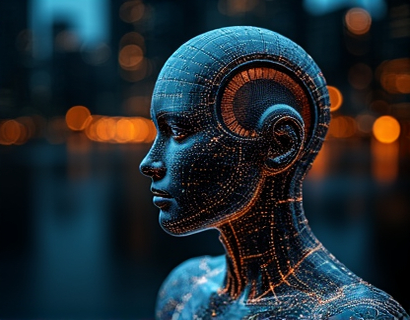Unlocking the Potential of Next-Generation Digital Experiences: The Synergy of AI and Crypto
The intersection of artificial intelligence (AI) and cryptocurrency is paving the way for a new era of digital transformation. This synergy is not just about combining two advanced technologies but about creating a powerful ecosystem that enhances user experiences, drives innovation, and fosters growth. As we delve into this topic, it's essential to understand how these technologies, when merged, can offer a competitive edge in the rapidly evolving tech landscape.
The Role of AI in Digital Transformation
Artificial intelligence has been a game-changer in various industries, from healthcare to finance. In the context of digital transformation, AI plays a crucial role by automating complex processes, providing insights through data analysis, and creating personalized user experiences. AI-driven systems can learn from vast amounts of data, adapt to new inputs, and perform tasks that traditionally required human intervention. This capability is particularly valuable in enhancing digital experiences, making them more intuitive, efficient, and engaging.
Enhanced User Experiences Through AI
One of the most significant impacts of AI on digital experiences is the ability to offer personalization. AI algorithms can analyze user behavior, preferences, and patterns to deliver tailored content, recommendations, and services. For instance, in e-commerce, AI can suggest products based on a user's browsing and purchase history, significantly improving the shopping experience. In entertainment, AI can curate playlists and recommend movies or shows that align with a user's tastes, keeping them engaged for longer periods.
Moreover, AI-powered chatbots and virtual assistants have revolutionized customer service. These AI-driven tools can handle a vast number of queries simultaneously, providing instant responses and support 24/7. This not only enhances user satisfaction but also reduces operational costs for businesses. The ability of AI to understand natural language and context makes these interactions seamless and natural, further elevating the user experience.
Cryptocurrency: A New Paradigm for Digital Transactions
Cryptocurrency, on the other hand, represents a fundamental shift in how we think about money and transactions. Unlike traditional currencies, cryptocurrencies operate on decentralized blockchain networks, ensuring transparency, security, and immutability. This technology has the potential to disrupt traditional financial systems by providing a more efficient, secure, and accessible way to conduct transactions.
The decentralized nature of cryptocurrencies means that they are not controlled by any single entity, reducing the risk of censorship and fraud. This is particularly appealing in a digital age where data privacy and security are paramount. Cryptocurrencies also enable peer-to-peer transactions without the need for intermediaries, reducing transaction costs and increasing speed. These features make cryptocurrencies an attractive option for businesses and individuals looking to streamline their digital transactions.
Combining AI and Crypto: A Synergistic Approach
The true power of AI and cryptocurrency is realized when they are combined. This synergy can drive innovation and create new opportunities for growth. For instance, AI can enhance the functionality and usability of cryptocurrency platforms, making them more accessible and user-friendly. Conversely, the transparency and security provided by blockchain can bolster the trust and reliability of AI systems.
One area where AI and crypto intersect is in the development of decentralized applications (dApps). These applications leverage blockchain technology to create transparent, secure, and tamper-proof environments. AI can be integrated into dApps to provide advanced features such as predictive analytics, fraud detection, and personalized user experiences. For example, a decentralized finance (DeFi) platform can use AI to optimize trading strategies, manage risks, and offer tailored financial services to users.
Enhancing Security and Trust
Security is a critical concern in both AI and cryptocurrency. AI systems, despite their advanced capabilities, are not immune to vulnerabilities such as data breaches and algorithmic biases. Similarly, cryptocurrencies have faced challenges related to security, including hacking and scams. However, when combined, these technologies can create a more robust security framework.
Blockchain's inherent security features, such as cryptographic hashing and consensus mechanisms, can protect AI systems from various attacks. For instance, AI models can be stored and executed on a blockchain, ensuring that the data and computations are tamper-proof. Additionally, AI can be used to monitor blockchain networks for suspicious activities, enhancing the overall security of the ecosystem. This mutual reinforcement of security measures builds trust among users, a crucial factor for widespread adoption.
Fostering Innovation and Growth
The combination of AI and cryptocurrency is not just about solving existing problems but also about creating new possibilities. This synergy can drive innovation in various sectors, from finance and healthcare to supply chain and beyond. For businesses, integrating AI and crypto can open up new revenue streams and market opportunities. For developers and entrepreneurs, it provides a fertile ground for experimentation and innovation.
Consider the potential of AI-driven marketplaces that utilize cryptocurrency for transactions. These platforms can offer unique incentives and rewards to users, encouraging participation and engagement. For instance, a marketplace for digital content creators could use AI to match creators with audiences based on content preferences and payment capabilities in cryptocurrency. This not only enhances the user experience but also creates a sustainable economic model for content creators.
User Engagement and Community Building
User engagement is a key factor in the success of any digital platform. The integration of AI and cryptocurrency can significantly enhance user engagement by creating more interactive and rewarding experiences. AI can analyze user behavior to design gamified elements, personalized challenges, and community-driven initiatives that keep users engaged and motivated.
Cryptocurrency can further enhance this by introducing token-based incentives. Users can earn tokens for participating in activities, contributing to the community, or achieving certain milestones. These tokens can be used within the platform or exchanged for other assets, creating a circular economy that encourages active participation. This approach not only boosts user engagement but also fosters a sense of community and ownership among users.
Challenges and Considerations
While the potential of AI and cryptocurrency is immense, there are challenges that need to be addressed. Regulatory uncertainties, technological complexities, and user adoption are among the key issues. Regulators are still catching up with the rapid advancements in these fields, leading to a patchwork of regulations that can hinder innovation. Technologically, integrating AI and blockchain requires significant expertise and resources. User adoption, particularly for cryptocurrency, depends on educating the public about its benefits and addressing concerns related to volatility and usability.
Despite these challenges, the benefits of combining AI and cryptocurrency are undeniable. By addressing these issues through collaboration, education, and innovation, the tech community can pave the way for a more secure, efficient, and engaging digital future.
Conclusion
The convergence of AI and cryptocurrency represents a transformative force in the digital landscape. By leveraging the strengths of both technologies, we can create more intuitive, secure, and engaging digital experiences. This synergy not only drives innovation and growth but also empowers users, fostering a more inclusive and dynamic tech ecosystem. As we continue to explore and harness this potential, the future of digital transformation looks brighter than ever.











































